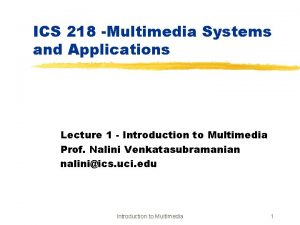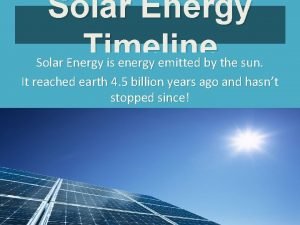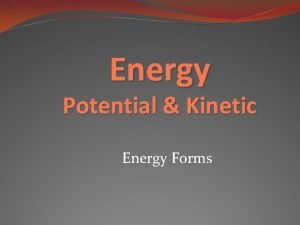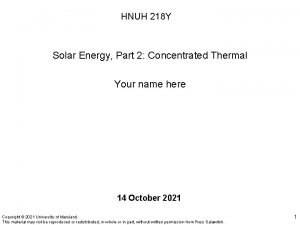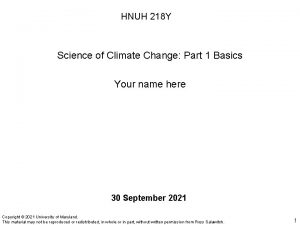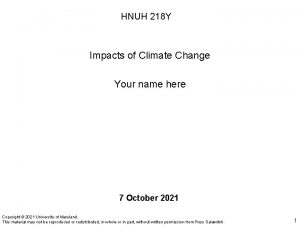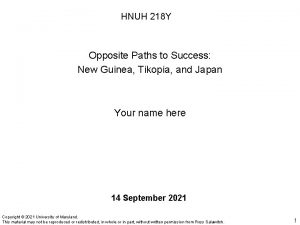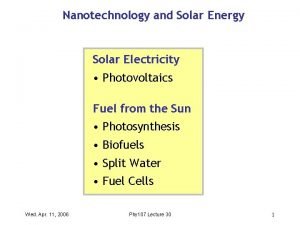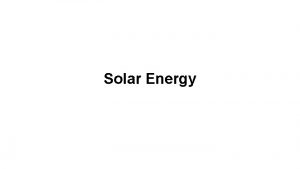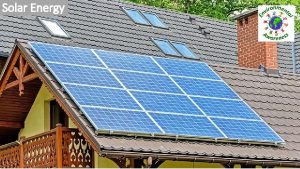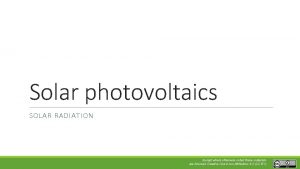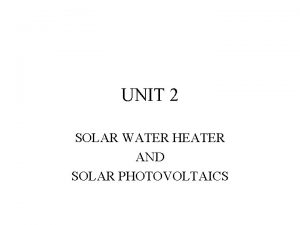HNUH 218 Y Solar Energy Part 1 Photovoltaics














- Slides: 14

HNUH 218 Y Solar Energy, Part 1: Photovoltaics Your name here 7 October 2021 Copyright © 2021 University of Maryland. This material may not be reproduced or redistributed, in whole or in part, without written permission from Ross Salawitch. 1

As an “ice breaker”, it is sometimes good to go through some of the Admission Ticket questions. If you’d like, you can start with: In the KH book, industry research firm Clean Edge makes a prediction of the total installed capacity for solar photovoltaics (PV) in year 2015: a) What was the prediction? b) What was the actual worldwide Total installed capacity reached in 2015, according to the entry in row "World Total" in the first table that appears on https: //en. wikipedia. org/wiki/Growth_of_photovoltaics given for year 2015? Please note that 1000 MW (mega watts) = 1 GW (giga Watts). Please "do the math" to be sure you are using the same units for your replies to a) and b) and, then comment on whether you think Fred Krupp and Miriam Horn would be pleased with what has actually happened? Copyright © 2021 University of Maryland. This material may not be reproduced or redistributed, in whole or in part, without written permission from Ross Salawitch. 2

You could discuss this Admission Ticket question: The KH book gives a numerical value for how much the price per peak watt for solar energy must be, for solar energy to be able to compete with “coal-fired electricity virtually everywhere”. This number appears twice in the reading; also the wiki page provides the same price per peak watt cost for solar energy to achieve economic parity with the grid. a) what is the price per peak watt for solar energy needed to achieve cost parity with coal? b) according to http: //solarcellcentral. com/markets_page. html when was this parity achieved? c) according to KH, what other additional critical hurdle must be overcome to enable solar-generated electricity to compete with coal-fired electricity virtually everywhere? Feel free to use this image from http: //solarcellcentral. com/markets_page. html and if you go this route, please spend time talking about c) (you can conduct your own research) because the hurdle of energy storage is huge. Wide spread adoption of solar energy, to meet base line demand, really will require overcoming the present limitation of the intermittency of solar energy. Copyright © 2021 University of Maryland. This material may not be reproduced or redistributed, in whole or in part, without written permission from Ross Salawitch. 3

Should you want to use this image that appears on page 19 of the print edition of the book, you are more than welcome to incorporate. You can probably find better images on the web Copyright © 2021 University of Maryland. This material may not be reproduced or redistributed, in whole or in part, without written permission from Ross Salawitch. 4

This website http: //solarcellcentral. com noted in the second AT question is succinct and has great graphics you can incorporate into the presentation. As a follow-up to the prior slide, might want to show and this image, which shows the annual growth (increase in capacity per year) of worldwide PVs This chart shows annual increase in solar PV http: //solarcellcentral. com/markets_page. html Copyright © 2021 University of Maryland. This material may not be reproduced or redistributed, in whole or in part, without written permission from Ross Salawitch. 5

This website http: //solarcellcentral. com noted in the second AT question is succinct and has great graphics you can incorporate into the presentation. As well as this image that shows “Worldwide Cumulative PV growth” which is the same as Installed Capacity http: //solarcellcentral. com/markets_page. html Can have various threads of discussion around these two slides, such as: why do you think the PV growth has been so rapid? what countries are leading this growth? Copyright © 2021 University of Maryland. This material may not be reproduced or redistributed, in whole or in part, without written permission from Ross Salawitch. 6

In some form or fashion, should try to address this Admission Ticket question: The KH book gives a numerical value for how much the price per peak watt for solar energy must be, for solar energy to be able to compete with “coal-fired electricity virtually everywhere”. This number appears twice in the reading; also the wiki page provides the same price per peak watt cost for solar energy to achieve economic parity with the grid. a) what is the price per peak watt for solar energy needed to achieve cost parity with coal? b) according to http: //solarcellcentral. com/markets_page. html when was this parity achieved? c) according to KH, what other additional critical hurdle must be overcome to enable solar-generated electricity to compete with coal-fired electricity virtually everywhere? Feel free to use this image from http: //solarcellcentral. com/markets_page. html and if you go this route, please spend time talking about c) (you can conduct your own research) because the hurdle of energy storage is huge. Wide spread adoption of solar energy, to meet base line demand, really will require overcoming the present limitation of the intermittency of solar energy. Copyright © 2021 University of Maryland. This material may not be reproduced or redistributed, in whole or in part, without written permission from Ross Salawitch. 7

Totally you call whether, and how, to work the third AT question: The KH book tells the story of three companies: one led by Conrad Burke, one led by Dave Pearce, and the third led by Bill Gross. a) State the name of one of these three companies and for each provide a succinct description of the innovation each company was attempting to place into the market. b) For the company in a), based either on your own independent web research or one of the links below, state what has happened to either the company of the CEO of the company, since the time the KH book was written. https: //www. reuters. com/article/us-dupont-innovalight/dupont-buys-solar-tech-company-innovalight-id. USTRE 76 O 36420110725 https: //www. greentechmedia. com/articles/read/Nuvo. Sun-CIGS-Solar-Startup-Acquired-by-Dow-Chemical https: //www. greenbiz. com/article/how-innovator-bill-grosss-solar-breakthrough-could-decarbonize-heavy-industry into the presentation! I think it is interesting that all three of these “characters” are still active in the solar PV business community. Copyright © 2021 University of Maryland. This material may not be reproduced or redistributed, in whole or in part, without written permission from Ross Salawitch. 8

I think the fourth AT question is important and quite central: Based on the table entitled "Top 10 PV countries in 2019 (MW)" on this website: https: //en. wikipedia. org/wiki/Photovoltaics state: a) the country with the most installed solar capacity in year 2019; b) the fraction of the total, global installed solar capacity in year 2019 that resides in this country (you might want to use a table from the link in Q 1 for the denominator of the needed expression) c) briefly state whether or not you are surprised by the answers to a) & b), based on how this country has been represented in prior assigned material. Copyright © 2021 University of Maryland. This material may not be reproduced or redistributed, in whole or in part, without written permission from Ross Salawitch. 9

You’re welcome to show this table from http: //solarcellcentral. com/markets_page. html and can have various threads of discussion around topics such as: What practice has the German government employed to facilitate the widespread use of solar? (this is covered in KH, the wiki, and solar cell central) Are students surprised by the rise of solar in China, especially given what Jared Diamond had written about China? Copyright © 2021 University of Maryland. This material may not be reproduced or redistributed, in whole or in part, without written permission from Ross Salawitch. 10

For the “rise of solar in China” question, can remind students I had shown the slide on the following page at the second class meeting, which does contain a significant commitment by China to halt the growth of their CO 2 emissions over a relatively short period of time, and the slide after that at the end of discussion 5 that had focused on China (i. e. , you are welcome to recycle these slides) Copyright © 2021 University of Maryland. This material may not be reproduced or redistributed, in whole or in part, without written permission from Ross Salawitch. 11

Obama & Xi US / China Announcement Paris Climate Agreement Nov 2014: Presidents Obama & Xi announced U. S. would reduce GHG emissions to 27% below 2005 by 2025 China would peak GHG emissions by 2030 with best effort to peak early Paris Climate Agreement: Article 2, Section 1, Part a): Objective to hold “increase in GMST to well below 2 C above pre-industrial levels and to pursue efforts to limit the temperature increase to 1. 5 C above pre-industrial levels” NDC: Nationally Determined Contributions to reduce GHG emissions Submitted prior to Dec 2015 meeting in Paris Consist of either unconditional (promise) or conditional (contingent) pledges Generally extend from early 2016 to year 2030 Copyright © 2021 University of Maryland. This material may not be reproduced or redistributed, in whole or in part, without written permission from Ross Salawitch. 12

Finally, should you so desire, you can present your answer to the final question on the AT 11: The KH book provides an estimate of how much land would be needed to produce enough electricity to power the entire US from solar photovoltaic technology. This estimate is based on a certain assumption for the efficiency of the solar PV. a) what is the “length of the square” (KH use the word “side”) that would be needed for the US to get all of its electricity needs from solar PV? b) what did KH assume about the efficiency of solar PV to arrive at this estimate? c) what would the “length of the square” (or “side”) be if the efficiency would rise to the highest achieved by the Boeing Spectrolab that is described on this wiki page: https: //en. wikipedia. org/wiki/Photovoltaics ? Note: to correctly answer c), you will need to relate two numbers from disparate sources: i. e. , one from the KH book & the other from the wiki page, and you will have to remember the relation between area of a square and the length of a side of a square. If you are struggling with the math, feel free to email Ross. If you want to run your answer by me to be sure it is correct, this will be fine of course Copyright © 2021 University of Maryland. This material may not be reproduced or redistributed, in whole or in part, without written permission from Ross Salawitch. 13

The materials in this chapter and the websites noted on the ATs should “easily” facilitate a 45 min discussion. Feel free to use whatever you’d like of what I have provided. Of course, fine to grab whatever additional figures you’d like anywhere off the web, highlight whatever aspects of the reading or websites you’d like, add your own info, etc. Good luck: and I’ll be happy to preview a draft ! Copyright © 2021 University of Maryland. This material may not be reproduced or redistributed, in whole or in part, without written permission from Ross Salawitch. 14
 49 cfr 217
49 cfr 217 What is an inexhaustible source of energy
What is an inexhaustible source of energy 28,5:2,5
28,5:2,5 Ics multimedia
Ics multimedia 218 harpa cristã
218 harpa cristã Wind energy is an indirect form of solar energy
Wind energy is an indirect form of solar energy Wholesale solar panel efficiency
Wholesale solar panel efficiency Energy energy transfer and general energy analysis
Energy energy transfer and general energy analysis Energy energy transfer and general energy analysis
Energy energy transfer and general energy analysis Solar radiation has a part in the water cycle by
Solar radiation has a part in the water cycle by Timeline of solar energy
Timeline of solar energy Solar irradiation
Solar irradiation Solar energy is radiant light and heat
Solar energy is radiant light and heat Form of energy
Form of energy Avi solar energy pvt ltd
Avi solar energy pvt ltd



